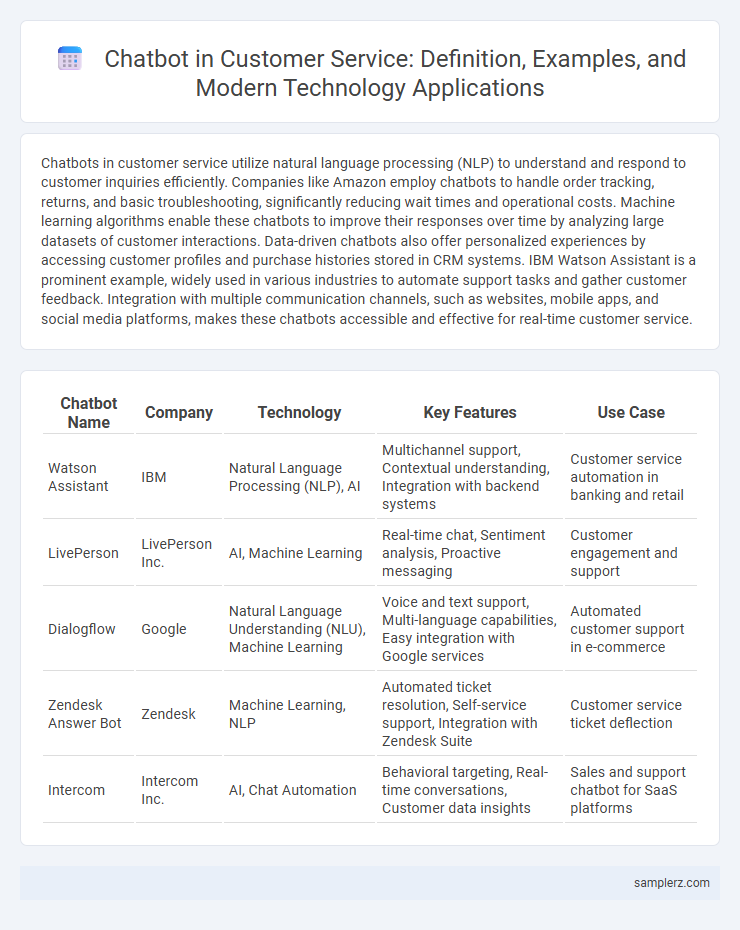Chatbots in customer service utilize natural language processing (NLP) to understand and respond to customer inquiries efficiently. Companies like Amazon employ chatbots to handle order tracking, returns, and basic troubleshooting, significantly reducing wait times and operational costs. Machine learning algorithms enable these chatbots to improve their responses over time by analyzing large datasets of customer interactions. Data-driven chatbots also offer personalized experiences by accessing customer profiles and purchase histories stored in CRM systems. IBM Watson Assistant is a prominent example, widely used in various industries to automate support tasks and gather customer feedback. Integration with multiple communication channels, such as websites, mobile apps, and social media platforms, makes these chatbots accessible and effective for real-time customer service.
Table of Comparison
| Chatbot Name | Company | Technology | Key Features | Use Case |
|---|---|---|---|---|
| Watson Assistant | IBM | Natural Language Processing (NLP), AI | Multichannel support, Contextual understanding, Integration with backend systems | Customer service automation in banking and retail |
| LivePerson | LivePerson Inc. | AI, Machine Learning | Real-time chat, Sentiment analysis, Proactive messaging | Customer engagement and support |
| Dialogflow | Natural Language Understanding (NLU), Machine Learning | Voice and text support, Multi-language capabilities, Easy integration with Google services | Automated customer support in e-commerce | |
| Zendesk Answer Bot | Zendesk | Machine Learning, NLP | Automated ticket resolution, Self-service support, Integration with Zendesk Suite | Customer service ticket deflection |
| Intercom | Intercom Inc. | AI, Chat Automation | Behavioral targeting, Real-time conversations, Customer data insights | Sales and support chatbot for SaaS platforms |
Introduction to Chatbots in Customer Service
Chatbots in customer service automate responses, providing 24/7 support and reducing wait times for customers. Advanced AI-driven chatbots interpret natural language queries to deliver personalized assistance across platforms like websites, social media, and messaging apps. Companies such as Amazon and Sephora utilize chatbots to enhance customer experience, streamline issue resolution, and gather valuable user data.
Top Real-World Chatbot Examples
Top real-world chatbot examples in customer service include Amazon's Alexa, which leverages natural language processing to handle customer inquiries efficiently. The H&M chatbot streamlines shopping by providing personalized fashion recommendations and order assistance. Another notable example, Bank of America's Erica, uses AI to deliver financial advice and seamless transaction support, enhancing the overall customer experience.
Chatbot Use Cases in Customer Support
Chatbots in customer support streamline query resolution by providing instant responses to common questions, reducing wait times and increasing customer satisfaction. For example, AI-powered chatbots like IBM Watson and LivePerson handle tasks such as order tracking, troubleshooting, and appointment scheduling with high accuracy. These chatbots also enable 24/7 availability, allowing businesses to maintain continuous engagement and support across multiple channels.
Notable Brands Leveraging Chatbots
Leading companies like Amazon, Apple, and Sephora utilize advanced chatbots to enhance customer service by providing instant responses and personalized assistance. These chatbots employ natural language processing (NLP) and machine learning algorithms to efficiently handle inquiries, process orders, and resolve issues. Integration of AI-driven chatbots reduces wait times and improves customer satisfaction across e-commerce, tech support, and retail industries.
AI-Powered Chatbots Enhancing User Experience
AI-powered chatbots such as Drift and Intercom revolutionize customer service by providing real-time, personalized interactions that significantly reduce response times and increase user satisfaction. These chatbots leverage natural language processing (NLP) and machine learning algorithms to understand and predict customer needs, enabling seamless issue resolution and proactive support. Integration with CRM systems further enhances data-driven insights, optimizing customer engagement and streamlining support workflows.
24/7 Customer Assistance with Chatbots
Chatbots provide 24/7 customer assistance by instantly responding to inquiries and resolving common issues without human intervention. Companies like IBM Watson Assistant and Zendesk Answer Bot utilize AI-driven natural language processing to deliver personalized support at any time. This constant availability reduces wait times, enhances user experience, and increases overall customer satisfaction.
Automated Query Resolution: Key Chatbot Examples
Automated query resolution in customer service is exemplified by chatbots like IBM Watson Assistant, which uses natural language processing to understand and respond to customer inquiries efficiently. Google Dialogflow enables seamless integration with multiple platforms, providing real-time assistance and reducing workload for human agents. Another key example, Zendesk Answer Bot, leverages AI to instantly resolve common questions, improving customer satisfaction and operational efficiency.
Successful Chatbot Integration Stories
Leading companies like Sephora and H&M have successfully integrated chatbots to enhance customer service by providing personalized shopping assistance and instant query resolution. IBM Watson-powered chatbots have reduced response times by up to 50%, significantly improving customer satisfaction rates. These implementations demonstrate the effectiveness of AI-driven chatbots in streamlining support operations and increasing customer engagement.
Measuring the Impact of Chatbots in Customer Service
Measuring the impact of chatbots in customer service involves analyzing key performance indicators such as response time, customer satisfaction scores, and resolution rates. Leading brands like Amazon and Sephora utilize AI-powered chatbots that reduce average handling time by up to 30%, enhancing user experience and operational efficiency. Data-driven insights from these metrics enable continuous optimization of chatbot algorithms, improving accuracy and personalized customer interactions.
Future Trends for Chatbots in Customer Support
Future trends for chatbots in customer support emphasize advanced natural language processing and AI-driven personalization, enabling more human-like interactions. Integration with real-time analytics and predictive capabilities allows chatbots to proactively resolve issues before customers are aware. The adoption of multimodal interfaces, combining voice, text, and visual inputs, is expected to enhance accessibility and user experience significantly.

example of chatbot in customer service Infographic
 samplerz.com
samplerz.com